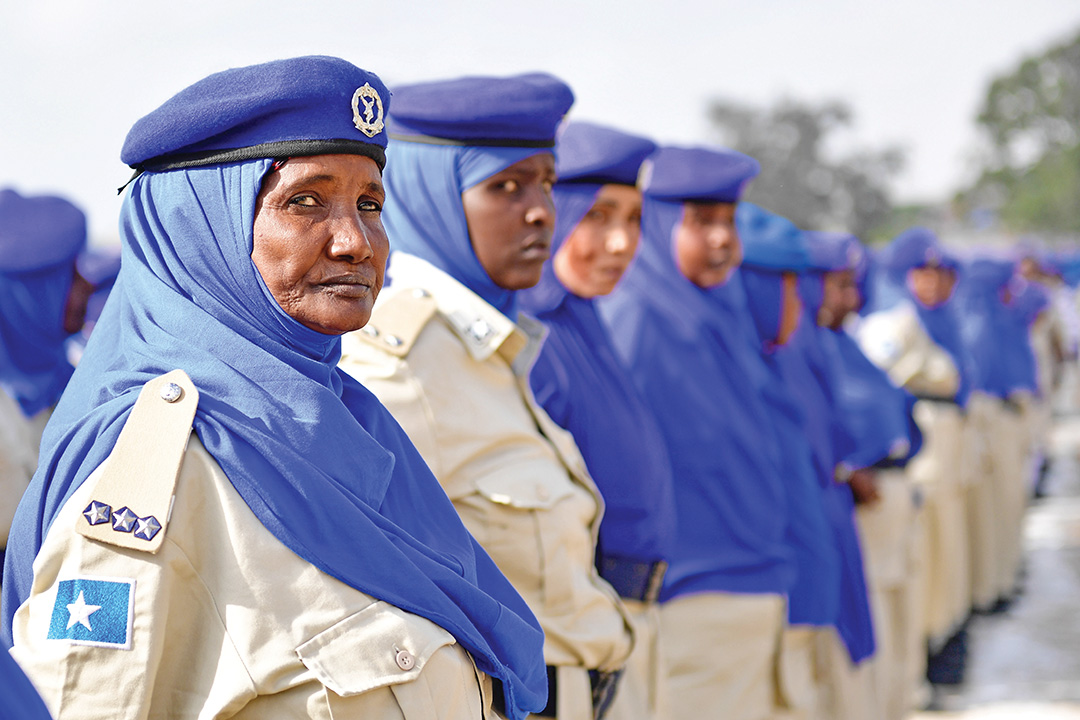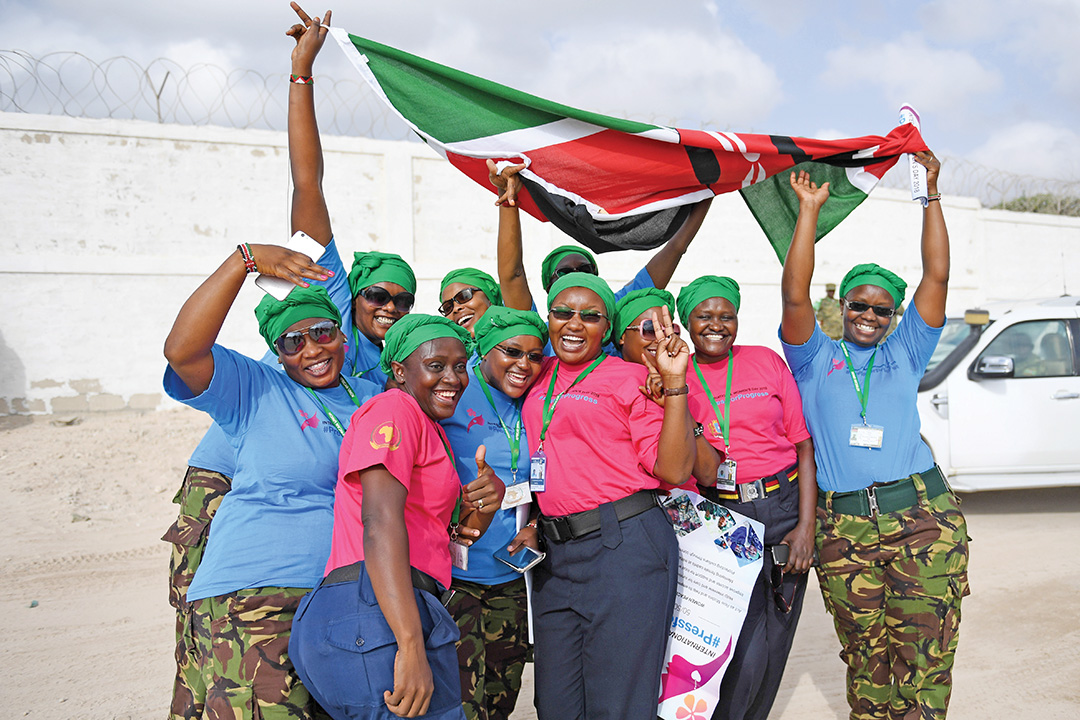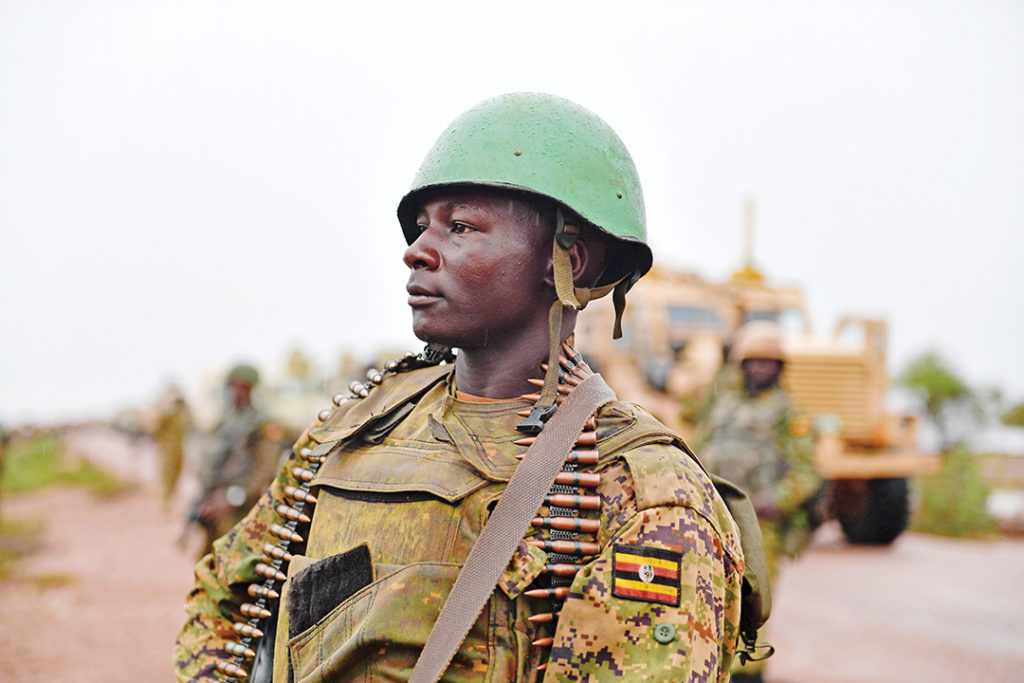The African Union Mission in Somalia has refined its message to counter al-Shabaab
ADF STAFF | photos by AMISOM
The African Union Mission in Somalia (AMISOM) sometimes has struggled to get its message out. The mission had several false starts in trying to communicate with Somali civilians, people in the troop-contributing countries and the world in general.
Now, over the course of the mission’s 11 years, its communications staff has learned to be flexible and to improvise. In May 2018, the mission began taking stock of itself and what it has accomplished — and invited journalists to participate in the process.
The self-study took about a month, with journalists from Burundi, Djibouti, Ethiopia, Kenya and Uganda — countries contributing troops to the mission — visiting Army bases around Somalia. Lt. Col. Richard Omwega, the mission’s spokesman, said he wanted the journalists to see what their countrymen were doing in Somalia.

“We want you to witness what is going on such that it informs your reporting on what these brothers and sisters are paying the price for,” he said, according to Uganda’s Daily Monitor.
AMISOM has been in Somalia since 2007 with a mandate to support the government in restoring peace and stability. Its mission is to build the capacity of Somali security forces and reduce the threats posed by al-Shabaab and other militant groups. The AMISOM mandate is scheduled to conclude in 2021, and the United Nations expects the mission to reduce its size along the way. In December 2017, the mission trimmed staffing by 1,000 and was expected to cut another 1,000 by October 2018, to about 20,600.
The mission has had its share of successes. It has protected two transitional Somali governments and electoral processes that produced new national governments in September 2012 and February 2017.
SKILLED OPPONENTS
Somalia has endured more than two decades of turmoil, and al-Shabaab represents the greatest threat to its stability. The extremist group wants to wreck Somalia’s central government and establish its own rule based on its strict interpretation of Islamic law. The group also conducts assaults in Kenya, mostly in the region bordering Somalia, to pressure the Kenyan government to withdraw its troops from Somalia.
Although al-Shabaab has had setbacks in recent months, it is still a dangerous force in Somalia and remains effective at getting its message out. In his 2018 study, “Strategic Communications for Peace Operations: The African Union’s Information War Against al-Shabaab,” Paul D. Williams of The George Washington University notes that the militants of al-Shabaab “have consistently and sometimes accurately, depicted successive Somali governments as weak, corrupt and illegitimate.”
“Al-Shabaab’s two most important tools were radio and the Internet,” Williams wrote. “It ran a ministry of information that used a network of FM radio stations (and some TV stations) known as al-Andalus and its rebranded media department Al-Kataib Media Foundation and News Channel produced material across multiple platforms in English and Somali, and branched out into Swahili, Norwegian, Swedish and even Urdu.”
Hate Speech International says al-Shabaab began its media messages in 2007 with propaganda films aimed mainly at recruiting foreign fighters.
“By 2009, the group had dramatically refined its media campaign and the quality of its audio-visual production, enabling its media apparatus to produce increasingly polished films alongside written, audio/radio, and photographic releases,” the investigative group concluded in a 2016 report.
Williams told ADF that al-Shabaab remains “a significant media presence” in Somalia. “It produces daily stories in Somali and works through a variety of media interlocutors to disseminate its key messages. It also continues to produce video materials, although seemingly at a reduced rate from a few years ago.”
AMISOM, he added, is doing a better job of responding to al-Shabaab propaganda.
“Nowadays, AMISOM produces lots more products than it used to, including short videos, an official mission magazine, and numerous press statements. Its principal focus today should be ensuring AMISOM becomes a trusted source of information, as well as challenging al-Shabaab’s strategic communications.”
MORE THAN PEACEKEEPERS
Somalia’s volatility has meant that, from the start, AMISOM peacekeepers have had to do more than those stationed in other parts of the world. In April and May 2018, AMISOM troops and Somali national security forces evacuated more than 10,000 people caught in raging floods.
Officials say AMISOM has long dealt with high expectations from Somalis and the international community. Cheryl Sim, a former advisor to the Combined Joint Task Force-Horn of Africa, told the intelligence group Cipher Brief that mission troops have been expected to engage in governing activities, including civic and humanitarian work — tasks that should be the responsibility of the Somali government and its regional governments. The mission, she said, has never been equipped or funded to carry out such work.

“If there is one point that I would make it is that the international community’s focus ought to be on Somalia’s security forces rather than trying to make AMISOM more effective, especially since it cannot go on indefinitely,” she told ADF. “Whether AMISOM has an effective communications strategy is beside the point when Somalia’s security forces, both military and civilian police, have not been either able or reliable to secure and hold areas vacated by al-Shabaab.”
The stability of the country, Sim said, rests firmly in the hands of Somalis. “Some might contend that AMISOM has not had the force enablers it needs to make greater advances, but without Somali forces capable of holding gains on their own, the issue of enablers is moot.”
GETTING THE MESSAGE OUT
AMISOM has worked to craft messages that explain the mission to civilians. In 2017, the International Refugee Rights Initiative published a study, “They Say They’re Not Here to Protect Us. Civilian Perspectives on the African Union Mission in Somalia.” The study was the result of interviews with 64 Somali citizens and showed that many didn’t understand what AMISOM is trying to accomplish.
“While most knew that AMISOM is tasked to conduct offensive operations against al-Shabaab and to protect government institutions, other aspects of the mandate were far less known,” the study reported. “This lack of proper understanding of the mandate contributed to severe criticism by some, especially those living in areas with high levels of insecurity.”
The report also showed that some peacekeepers are better than others. Many of those interviewed expressed distrust of some contingents within AMISOM due to past conflicts. But the peacekeeping contingent from Djibouti was much better regarded, “mainly because of their efforts to build community relations and provide services to nearby communities.” Members of the Horn of Africa task force have noted that the Djiboutian contingent is keen on improving its communications skills.
Some of those interviewed complained about abuses committed by peacekeepers themselves. Those abuses could not be verified or documented. The report noted that AMISOM had set up several mechanisms to deal with such abuses, but the alleged victims were not aware that the remedies existed.
The report concluded that AMISOM needed to communicate better: “AMISOM needs to address the commonly held perception that it is unable to protect civilians and ensure more effective communication with the local population about the mission’s mandate, activities and exit strategy.”
REACHING PEOPLE THROUGH RADIO
Radio has long been the dominant form of media in Africa, and AMISOM has integrated it into its media campaigns. In 2010, AMISOM’s information support team produced The Misleaders, a 10-part radio drama aimed at undercutting al-Shabaab by focusing on the tactics it uses to indoctrinate young people and women. Each episode was 30 minutes long. The series was followed by another 10-episode production, Happy People Can’t Be Controlled.
The information team also has produced a number of videos, including Gate of Hope, Somalia Back from the Brink, AMISOM Hospital, and Mayor of Mogadishu. Unlike the radio dramas, the videos are mostly in English, targeting audiences outside Somalia.
In 2016, AMISOM began training its public information officers to use “Radio in a Box” technology. It’s a portable, affordable broadcasting system that includes a laptop computer, audio mixer, digital audio recorder, media player, microphones, and other equipment to quickly and easily establish a temporary radio station in remote areas or disaster locations. AMISOM officials said the systems would be used to improve communications between the mission and local populations.

“In Somalia, radio is a vital communication tool used to broadcast information with radio ownership possibly exceeding 80 percent,” Col. Daher Aden, acting AMISOM military chief of staff, said during the start of the official training for the systems. “One advantage of this concept is its ability to broadcast vital information immediately to a large audience in the event of a crisis. The military can use the capability to communicate to villagers and elders and share thoughts with the community. This will improve the troops’ ability to interact better with the local populations.”
In April 2018, AMISOM began reviewing its information and communications technology capabilities to improve its effectiveness. The Centre for African Journalists News Africa reported that a team of 39 information and communications executives were conducting a technical and asset review to improve communication systems and secure networks.
“For any peace support operations to function effectively, or any other operation, military command and control depends on a complex communication network of equipment, personnel and communication protocols to relay information among forces,” Maj. Gen. Charles Tai Gituai, AMISOM deputy force commander in charge of operations and planning, told the news service.
FOUR LESSONS
In his 2018 study, Williams lists four critical communications lessons learned by AMISOM:
Deploying a peace operation without the capabilities to wage an effective strategic communications campaign is a major error. Williams said the African Union needs a standing strategic communications capability that it can apply to all future peacekeeping operations. Such a capability would include developing policy and plans. Since there is no one single strategy that works in all situations, the AU capability should include adaptability “in accordance with the needs on the ground.”
Make sure your communications policy message is clear, coherent and workable. State your goals and explain how particular audiences can be reached and influenced. For AMISOM, it was not enough to come up with a clear policy; it had to be implemented by the countries involved in the mission.
Effective strategic communications on a mission often require an exploratory mindset and a willingness to take risks. In the case of AMISOM, communicators needed to evolve quickly on the job. The information team, Williams said, was initially designed to “ensure a strategically focused and decentralized approach to project design.” After 2013, that approach was largely stopped. AMISOM’s information team had to adapt, and “the ability to take risks was crucial.”
Because of the need for expertise in local conflict dynamics, you’re probably going to need a mostly local team to ensure long-term success. With AMISOM, there initially was no local expertise available that was capable of managing a communications mission of such scope and complexity. Over time, the situation improved to the point that the information support team was more than 50 percent local.
Poor communications in missions like AMISOM are often blamed on a lack of money and resources. But Williams told ADF that other factors are more important.
“All peace operations need the resources to stand up an effective strategic communications team,” he said. “This needn’t be particularly expensive, but it does need sustained political support from the mission leadership and contributing countries. It also needs to develop a clear and coherent communications strategy for delivering products that support the implementation of its mandated tasks.”
Williams added that reliability remains the critical factor in AMISOM’s communications strategy.
“AMISOM’s communications should target multiple audiences, and the importance of these audiences could vary depending on the task at hand,” he said. “It is a difficult balancing act to ensure that the right kind of messages reach the local population, the host government, the external partners, and the contributing countries and peacekeepers. But for all these audiences, AMISOM’s strategic communications team needs to develop a reputation as a trusted and reliable source of information. Without credibility, no amount of communications products will help the mission.”

